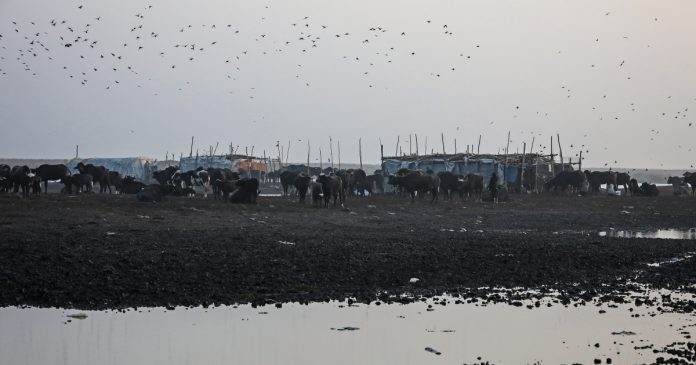[ad_1]
President Joe Biden has been elected on a promise, among others, to move the United States towards an ambitious new climate agenda – a feat that will require a radical transformation of thinking and practices across all areas of American policymaking.
For the US to become a global leader in climate policy, and instigate real change, it is integral that this transformation is not limited to domestic affairs, and that America’s actions in the international arena are also guided by a concern for the environment. To do so will require not just increased engagement in climate diplomacy, but a total re-evaluation of America’s hard and soft foreign policy tools, including economic sanctions.
In the post-Cold War era, economic sanctions have become the US foreign policy instrument of choice. These measures were initially seen as an effective, and morally acceptable, alternative to conventional war. However, it has since been established that sanctions have impacts on the populations of targeted states that are comparable to those of war, such as increased levels of poverty and significant declines in the GDP per capita. Moreover, economic sanctions also damage the environment, pushing targeted states to pursue aggressive and unsustainable development policies at the expense of accelerated environmental degradation in an effort to survive.
In recent years, the unintended humanitarian consequences of economic sanctions have been the subject of much discussion both in academia and policy-making circles. Despite the growing awareness about its humanitarian impacts, however, US policymakers have consistently overlooked the impacts this foreign policy tool can have on the environment.
Economic sanctions as a catalyst for environmental degradation
The impact of economic sanctions on the environment is perhaps most visible in the case of Iran, a nation that has been subject to incessant economic pressure – mainly by the US – for more than 40 years.
Today, Iran is experiencing not only intense social and economic distress but also an ever-worsening environmental crisis – both, at least in part, as a result of US sanctions.
US economic sanctions impeded Iran’s ability to pursue sustainable development policies and implement efficient environmental protections for years.
After the signing of the Iran nuclear deal (Joint Comprehensive Plan of Action, JCPOA) by the Obama administration in 2015, it was anticipated that the consequent lifting of sanctions would allow Iran to engage in a much-needed exchange of knowledge, capital, and technology. This would have paved the way for the country to develop the necessary capabilities to abandon outdated industrial and agricultural practices that are leading to environmental degradation.
But following Donald Trump’s election as president, such prospects gradually became illusory. In 2018, the Trump administration not only withdrew the US from the JCPOA but also embarked on a “maximum pressure” campaign against Iran
Ever since, Tehran has been subjected to arguably the most testing economic sanctions since it was first sanctioned by Washington in 1979 in the aftermath of the Islamic Revolution.
Although the Trump administration has consistently claimed its “maximum pressure” campaign on Iran was “targeted at the regime, and not the people of Iran”, the reinstatement of sanctions targeted critical sectors of the country’s economy, such as energy, shipping, automotive, aviation and finance, which are all crucial to sustainable development.
Trump’s sanctions also had an impact on the country’s environment. The economic distress triggered by the measures left the Iranian state less able, and willing, to pursue sustainable policies and reform its polluting industries. Moreover, sanctions impeded Iran’s ability to receive grants for environmental efforts from international funding institutions, such as the Global Environment Facility (GEF), a subsidiary of the World Bank.
Though much of the blame for Iran’s current environmental predicament must be attributed to endemic oversight and mismanagement on the part of Iranian policymakers, it is undeniable that sanctions have had damaging secondary consequences on the environment, not only in Iran but also in neighbouring Iraq.
Iraq is also suffering from the US sanctions on Iran
Washington lifted an overwhelming majority of the sanctions it imposed on Iraq in the 1990s after invading the country and removing Saddam Hussein from power in 2003. Ever since, the US has pursued policies in the region that are seemingly aimed at supporting Iraq’s economic recovery. However, US policies in neighbouring Iran have indirectly provoked environmental insecurity, and socioeconomic distress, in Iraq.
The land straddling the Iran-Iraq border is rich in natural resources – it has been long prized for its vast oil and gas reserves and is also very agriculturally fertile and valuable.
In recent decades, natural resources in this area have been plundered by both nations with little regard for the environment. Most notably, significant sections of the biodiverse Mesopotamian Marshes, a recognised UNESCO World Heritage Site located in southern Iraq and southwestern Iran, have been partially drained to reclaim land for agriculture or oil exploration. As a result, this formerly revered “cradle of civilisation” is now increasingly desolate and parched.
On the Iranian side of the border lies the province of Khuzestan, which has suffered badly from the country’s environmental troubles. Since the 1970s, due to aggressive dam-building and river water transfers aiming to provide for Iran’s arid central provinces, the province’s formerly expansive and fertile marshes and cultivable lands have been rapidly drying up. The growing food and water insecurity caused by environmental degradation also caused significant social distress in the region, with regular anti-government protests taking place in Khuzestan’s provincial capital, Ahvaz.
Across the border in Iraq, a very similar situation is at play. The quality and quantity of water entering the country have been drastically impacted by Iranian activities upstream. Falling river flows are drying up the country’s fertile marshes and cultivable lands in the southeast. Vast areas of previously fertile land are fast becoming arid, leading to rural poverty and creating a suitable recruiting ground for extremist groups. As rural opportunities decline, many are migrating to over-populated cities, placing increased pressure on the country’s already failing urban infrastructure. In the southeastern city of Basra, water shortages and contaminated drinking water have created undue strains on the country’s crumbling healthcare system, triggering widespread violent protests in 2018.
Decades of US sanctions against Iran, the legacy of the Iran-Iraq war between 1980 and 1988, and the ongoing conflicts in Iraq have hampered the ability of both Iran and Iraq to effectively address environmental challenges they are currently facing, including water scarcity. Compounded by demographic transformations, recurrent droughts and the chronic mismanagement of local resources, and the effects of climate change, these factors led to severe environmental degradation in the region.
While it was ultimately the decision of the Iranian policymakers to recklessly pursue development without any concern for the environment, it can be argued that the US economic sanctions left them without many other options. Prolonged economic sanctions limited Iran’s access to resources, compelling it to find ways to become self-sufficient. In an attempt to achieve industrial and agricultural development under these conditions, Iranian policymakers overextended the nation’s finite domestic water resources, critically destabilising the environment.
Towards an environmentally conscious foreign policy
For now, the environmental security of Iran does not appear to be a priority for American policymakers. However, Iran’s environmental struggles can potentially have grave implications for regional and global security.
These days, the nexus between climate change and security issues is stimulating great discussion among academics and policymakers, and climate change is increasingly being perceived in the policy realm as a security “threat multiplier” – especially in developing states and conflict zones. It has become apparent that socio-political change, human mobility, urbanisation and climate change are interrelated realities that can no longer be viewed in silos.
Extreme climate events, such as droughts and floods, have the potential to significantly impact water resource management, agricultural yields, and critical infrastructure in vulnerable regions of the world. While there is no direct causal link between environmental damage and economic sanctions, as it is in the case of Iran, sanctions can act as a “catalyst” in promoting environmental degradation with local, regional and global implications.
America’s foreign policy towards Iran undoubtedly contributed to the myriad environmental, political and social problems the country is currently facing, especially in the areas near its border with Iraq. The pursuit of short-term power and political gains have superseded intermediate and long-term interests in sustaining some of the region’s most important ecological resources. As the environment is now increasingly viewed as a matter of shared responsibility on an international level, the US cannot continue to overlook the environmental footprint of its foreign policy.
Moving onward, it is imperative for the US to place environmental considerations at the forefront of its foreign policy and examine the potential environmental consequences of the sanctions it imposes on nations. This can be achieved by paying increased attention to the information gathered on the potential humanitarian and environmental costs of sanctions before implementing a new policy agenda.
In the same respect, Iranian policymakers should be more cognisant of the environmental consequences of their actions. Instead of pushing for development at all costs, they should explore how to mitigate the irreparable impacts economic sanctions and political pressures can have on their local environment.
Further, financial mechanisms that are currently being used to continue humanitarian trade with Iran without breaking US sanctions, such as the European Instrument in Support of Trade Exchanges (INSTEX), should be expanded to also allow for the exchange of environmental technologies and know-how.
President Joe Biden has promised to redesign America’s Iran policies and abandon his predecessor’s punitive use of economic sanctions. By holding this promise, he can not only help improve the economic and security conditions in both Iran and Iraq but also protect the environment. Thus, the Biden administration should pursue cautious re-engagement with Iran, though gaining Iran’s trust following the US’s departure from the JCPOA will be challenging. If appropriately allocated, small and gradual sanctions concessions can provide Iran with the needed capital to fund social venues and combat coronavirus locally, which will improve living conditions for the Iranian public and ease tensions along the Iran-Iraq border.
The US cannot reclaim a leadership position in the global fight against climate change without putting the environment at the forefront of its foreign policy decisions. By moving towards a more environmentally focused foreign policy model when engaging with Iran, the Biden administration can contribute to, rather than further erode, the environmental security of Iran, Iraq, the Middle East, and the wider world.
The views expressed in this article are the authors’ own and do not necessarily reflect Al Jazeera’s editorial stance.
[ad_2]
Source link











